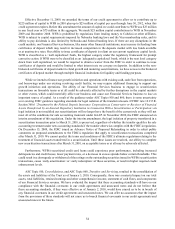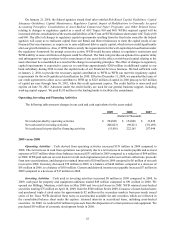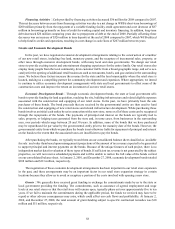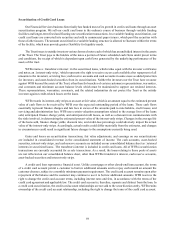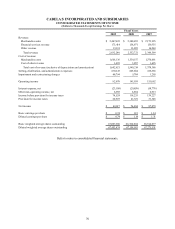Cabela's 2009 Annual Report Download - page 73
Download and view the complete annual report
Please find page 73 of the 2009 Cabela's annual report below. You can navigate through the pages in the report by either clicking on the pages listed below, or by using the keyword search tool below to find specific information within the annual report.64
Long-Lived Assets
Long-lived assets other than goodwill and other intangible assets, which generally are tested separately for
impairment on an annual basis, are evaluated for impairment whenever events or changes in circumstances indicate
that the carrying value may not be recoverable. When we evaluate long-lived assets for potential impairment, we first
compare the carrying value of the asset to that asset’s estimated future undiscounted cash flows. If the estimated
future cash flows are less than the carrying value of the asset, we then calculate an impairment loss. The calculation
for an impairment loss compares the carrying value of the asset to that asset’s estimated fair value, which may be
based on estimated future discounted cash flows or quoted market prices. We recognize an impairment loss if the
asset’s carrying value exceeds its estimated fair value. If we recognize an impairment loss, the newly adjusted
carrying amount of the asset becomes its new basis. For a depreciable long-lived asset, the new cost basis will be
depreciated over its remaining useful life. Frequently our impairment loss calculations contain multiple uncertainties
because they require management to make assumptions and to apply judgment to estimate future cash flows and
asset fair values, including forecasting cash flows under different scenarios, determining a discount rate that reflects
the risk inherent in future cash flows, and incorporating financial data from other parties. We have consistently
applied our accounting methodologies that we use to assess impairment loss. However, if actual results are not
consistent with our estimates and assumptions used in estimating future cash flows and asset fair values, we may be
exposed to losses that could be material.
Asset Securitization
WFB securitizes the majority of its credit card loans, and recognizes gains or losses on the sales, as well as
records certain retained interests, including transferor’s interest, interest only strips, cash reserve accounts, cash
accounts, and asset-backed securities, which are all subject to significant valuation assumptions. The interests
in securitized receivables, including interest only strips, cash reserve accounts, cash accounts, and asset-backed
securities, are reported at fair value in the consolidated balance sheets. The transferor’s interest is reported at the
lower of cost or market in the consolidated balance sheets. On a quarterly basis, we reviewed and adjusted, as
appropriate, the assumptions and estimates used in determining the fair value of the related accounts recognized
in connection with these securitization transactions. If we had made different assumptions for the periods covered
by the consolidated financial statements, WFB’s financial position and results of operations could have differed
materially. Refer to Note 3 for the sensitivity analysis of the current fair value of the interest only strip, cash reserve,
and cash accounts, and the impact on fair value from an immediate adverse change of 10% and 20% in the key
economic assumptions used to determine fair value.
Recent Accounting Standards and Pronouncements
Effective December 30, 2007, we adopted the provisions of Financial Accounting Standards Board (“FASB”)
ASC Topic 820, Fair Value Measurements and Disclosures. This statement defines fair value, establishes a hierarchal
disclosure framework for measuring fair value, and requires expanded disclosures about fair value measurements.
The provisions of this statement apply to all financial instruments that are being measured and reported on a fair
value basis. The partial adoption of ASC Topic 820 did not have any impact on our financial position or results of
operations. Effective December 28, 2008, we adopted the remaining provisions of ASC Topic 820 that were delayed
by the issuance of ASC Section 820-10-55, Fair Value Measurements and Disclosures: Overall: Implementation
Guidance and Illustrations. The adoption of the remaining provisions of ASC Topic 820, relating to nonfinancial
assets and liabilities, did not have a material impact on our financial position or results of operations.
In December 2007, the FASB issued ASC Topic 805, Business Combinations, which replaced FAS No. 141.
ASC Topic 805 establishes principles and requirements for how the acquirer of a business recognizes and measures
in its financial statements the identifiable assets acquired and the liabilities assumed. We adopted the provisions of
ASC Topic 805 effective December 28, 2008, which applies prospectively to all business combinations entered into
on or after such date. The adoption of this statement had no effect on our financial position or results of operations.
Any future acquisitions will be impacted by application of this statement.


